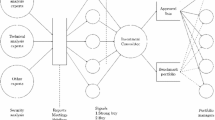Abstract
The ranking of MBA programmes by newspapers and magazines is common and usually controversial. This paper discusses the use of the most popular method of making these rankings via a multicriteria model which uses the weighted sum of a number of performance measures to give an overall score on which selection or ranking may be based. The weights are a quantitative model of the preferences of those making the evaluation. Many methods are available to obtain weights from preference statements so that for any set of preferences a number of different weight sets can be found depending on the method used. Cognitive limits lead to inconsistency in preference judgements so that weights may be subject both to uncertainty and to bias. It is proposed that choosing weights to minimize discrimination between alternatives (not weights) guards against unjustified discrimination between alternatives. Applying the method to data collected by the Financial Times shows the effect of varying the level of discrimination between weights and also the effect of using a reduced data set made necessary by the partial publication of information.





Similar content being viewed by others
References
Barnes J (1982). Medicine, experience and logic . In: Barnes J, Brunschwig J, Burnyeat M and Schofield M (eds). Science and Speculation: Studies in Hellenistic Theory and Practice. Cambridge University Press: Cambridge, pp. 3–28.
Barron H and Schmidt CP (1988). Sensitivity analysis of additive multiattribute value models. Opns Res 36: 122–127.
Bickerstaffe G and Ridgers B (2007). Ranking of business schools. J Mngt Dev 26: 61–66.
Borcherding K, Schmeer S and Weber M (1995). Biases in multiattribute weight elicitation. In: Caverni J-P, Bar-Hillel M, Barron FH and Junngermann H (eds). Contributions to Decision Making—I. Elsevier: Amsterdam.
Bradshaw D (2007). Business school rankings: The love–hate relationship. J Mngt Dev 26: 54–60.
Breiman L, Friedman JH, Olshen RA and Stone CJ (1998). Classification and Regression Trees. CRC: Boca Raton, FL.
Colbert A, Levary RR and Shaner MC (2000). Determining the relative efficiency of MBA programs using DEA. Eur J Opl Res 125: 656–669.
Dichev I (1999). How good are business school rankings? J Bus 72: 201–213.
Engwall L (2007). The anatomy of management education. Scand J Mngt 23: 4–35.
Gabert P and Brown DE (1989). Knowledge-based computer-aided design of materials handling systems. IEEE Trans Syst Mngt Cybernet SMC-19: 188–196.
Green RH and Doyle JR (1995). On maximising discrimination in multiple criteria decision making. J Opl Res Soc 46: 192–204.
Herfindahl OC (1950). Concentration in the U.S. steel industry. PhD Thesis. Columbia University, New York.
Hirschman AO (1964). The paternity of an index. Am Econ Rev 54: 761–762.
Jaynes ET (1957). Information theory and statistical mechanics. Phys Rev 106: 620–630 and 108: 171–190.
Jaynes ET (2003). Probability Theory: The Logic of Science. Cambridge University Press: Cambridge.
Jessop A (1999). Entropy in multiattribute problems. J Multi-Criteria Decision Anal 8: 61–70.
Jessop A (2004). Sensitivity and robustness in selection problems. Comput Opns Res 31: 607–622.
Mar-Molinero C and Mingers J (2007). An evaluation of the limitations of, and alternatives to, the Co-Plot methodology. J Opl Res Soc 58: 874–886.
Markowitz H (1952). Portfolio selection. J Finance 7: 77–91.
Mustajoki J, Hämäläinen RP and Lindstedt MRK (2006). Using intervals for global sensitivity and worst-case analyses in multiattribute value trees. Eur J Opl Res 174: 278–292.
Paucar-Caceres A and Thorpe R (2005). Mapping the structure of MBA programmes: A comparative study of the structure of accredited AMBA programmes in the United Kingdom. J Opl Res Soc 56: 25–38.
Peters K (2007). Business school rankings: Content and context. J Mngt Dev 26: 49–53.
Policano AJ (2005). What price rankings? BizEd 4: 26–32.
Policano AJ (2007). The rankings game: and the winner is? J Mngt Dev 26: 43–48.
Royal Statistical Society (2003). Performance Indicators: Good, Bad and Ugly. Report of the Royal Statistical Society Working Party on Performance Monitoring in the Public Services. Royal Statistical Society: London.
Segev E, Raveh A and Farjoun M (1999). Conceptual maps of the leading MBA programs in the United States: Core courses, concentration areas, and the ranking of the school. Strategic Mngt J 20: 549–565.
Siemens JC, Burton S, Jensen T and Mendoza NA (2005). An examination of the relationship between research productivity in prestigious business journals and popular press business school rankings. J Bus Res 58: 467–476.
Simpson EH (1949). Measurement of diversity. Nature 163: 688.
Soofi ES (1990). Generalized entropy-based weights for multiattribute value models. Opns Res 38: 362–363.
Soofi ES and Retzer JJ (1992). Adjustments of importance weights in multiattribute value models by minimum discrimination information. Eur J Opl Res 60: 99–108.
Theil H (1972). Statistical Decomposition Analysis: With Applications in the Social and Administrative Sciences. North-Holland: Amsterdam.
Thomas H (2007). Business school strategy and the metrics for success. J Mngt Dev 26: 33–42.
Tversky A and Kahneman D (1974). Judgement under uncertainty: Heuristics and biases. Science 185: 1124–1131.
Author information
Authors and Affiliations
Corresponding author
Rights and permissions
About this article
Cite this article
Jessop, A. A portfolio model for performance assessment: the Financial Times MBA ranking. J Oper Res Soc 61, 632–639 (2010). https://doi.org/10.1057/jors.2008.193
Received:
Accepted:
Published:
Issue Date:
DOI: https://doi.org/10.1057/jors.2008.193




